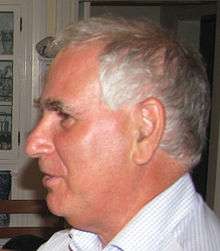Tom Rapoport
Tom Abraham Rapoport (born June 17, 1947)[1] is a German-American cell biologist who studies protein transport in cells. Currently, he is a professor at Harvard Medical School and a Howard Hughes Medical Institute investigator. Born in Cincinnati, OH, he grew up in the German Democratic Republic. In 1995 he accepted an offer to become a professor at Harvard Medical School, Boston. In 1997 he became an investigator of the Howard Hughes Medical Institute.
Tom Rapoport | |
|---|---|
 | |
| Born | June 17, 1947 Cincinnati, Ohio |
| Citizenship | United States, Germany (East Germany until 1990) |
| Employer |
|
Biography
Rapoport was born in Cincinnati in 1947.[1] His parents, Samuel Mitja Rapoport and Ingeborg Rapoport, had fled the Nazis, and when he was three years old, they fled the United States in 1950 due to being investigated for un-American activities. After a brief stay in Vienna, they finally settled in Berlin in the German Democratic Republic in 1952, where his father became a Professor for Biochemistry and director of the Institute of Physiological Chemistry of the Humboldt-University, and his mother became a Professor for neonatology at the Charite Hospital. His brother is mathematician Michael Rapoport. Tom A. Rapoport received his PhD on mathematical modeling of the kinetics of inorganic pyrophosphatase in 1972 from Humboldt University.[2] He worked in the lab of Peter Heitmann, and his father, Samuel Mitja Rapoport, was head of the Institute of Physiological Chemistry.[2] At Humboldt he collaborated with Reinhart Heinrich on the mathematical modeling of glycolysis in red blood cells, leading to the establishment of metabolic control theory on which they submitted a joint 'habilitation' thesis.[3] At the same time he worked with Sinaida Rosenthal, a former student of his father, on cloning the insulin gene from carp.[2]
In 1979 he moved to the Zentralinstitut für Molekularbiologie der Akademie der Wissenschaften der DDR, later called the Max Delbrück Center for Molecular Medicine, where he became a professor in 1985. He moved to the United States, the country his parents fled from in 1950, in 1995. He has been a professor at the Harvard Medical School since 1995, and an HHMI investigator since 1997.
He studies several aspects of cellular secretion, including the mechanisms by which newly synthesized proteins are translocated from the cytosol to the lumen of the endoplasmic reticulum by the Sec61 complex (also known as the translocon), how misfolded secretory proteins are degraded by endoplasmic reticulum associated protein degradation (also known as ERAD), and how reticulons and related proteins regulate the morphology of the endoplasmic reticulum.
Selected research articles
- Voeltz, GK; Prinz WA; Shibata Y; Rist JM; Rapoport TA (10 February 2006). "A class of membrane proteins shaping the tubular endoplasmic reticulum". Cell. 124 (3): 573–586. doi:10.1016/j.cell.2005.11.047. PMID 16469703.
- Ye, Y; Shibata Y; Yun C; Ron D; Rapoport TA (24 June 2004). "A membrane protein complex mediates retro-translocation from the ER lumen into the cytosol". Nature. 429 (6994): 841–847. doi:10.1038/nature02656. PMID 15215856.
- Van den Berg B, Clemons WM Jr, Collinson I, Modis Y, Hartmann E, Harrison SC, Rapoport TA (1 January 2003). "X-ray structure of a protein-conducting channel". Nature. 427 (6969): 36–44. doi:10.1038/nature02218. PMID 14661030.
- Görlich, D; Rapoport TA (19 November 1993). "Protein translocation into proteoliposomes reconstituted from purified components of the endoplasmic reticulum membrane". Cell. 75 (4): 615–630. doi:10.1016/0092-8674(93)90483-7. PMID 8242738.
- Heinrich, R; Rapoport TA (15 February 1974). "A linear steady-state treatment of enzymatic chains. General properties, control and effector strength". Eur. J. Biochem. 42 (1): 89–95. doi:10.1111/j.1432-1033.1974.tb03318.x. PMID 4830198.
Awards
- 2004 Awarded Otto Warburg Medal of the German Society for Biochemistry and Molecular Biology
- 2005 Awarded Max Delbrück Medal of the Max Delbrück Center for Molecular Medicine.[4]
- 2007 Sir Hans Krebs Medal
- 2011 Awarded the Schleiden Medal from the Leopoldina[5]
References
- "Tom Abraham Rapoport". Berlin-Brandenbergische Akademie der Wissenschaften (in German). Retrieved 4 November 2010.
- Davis, Tinsley H. (4 October 2005). "Profile of Tom A. Rapoport". Proc Natl Acad Sci U S A. The National Academy of Sciences. 102 (40): 14129–14131. doi:10.1073/pnas.0506177102. PMC 1242311. PMID 16186492.
- Rapoport, Tom. "Reinhart Heinrich — An Unassuming Intellectual Giant". Journal of Theoretical Biology. Retrieved 7 November 2010.
- "Harvard Biochemist Tom Rapoport Awarded Max Delbrück Medal in Berlin". Max Delbrück Center for Molecular Medicine (MDC) Berlin-Buch. 1 December 2005. Archived from the original on 3 January 2011. Retrieved 4 November 2010.
- http://www.leopoldina.org/en/press/press-releases/press-release/press/986/